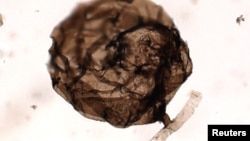Scientists made a big discovery in Canada, but it is something so small you need a microscope to see it.
The scientists reported discovering what they believe is the remains of the oldest-known fungus, which could be up to 1 billion years old. They found it in the Arctic area of Canada and named it Ourasphaira giraldae.
A report on their find was published in the journal Nature.
The multi-celled fungus is an ancestor to a large group of organisms, which today includes mushrooms, yeasts and molds. Ourasphaira lived where a river runs into a sea, about 900 to 1 billion years ago. That is two times older than earlier scientific fungus finds.
Until now, the oldest known fossil fungus, found in Scotland, was about 410 million years old.
But some researchers are not yet sure that the fossil is truly a fungus. Mary Berbee, a scientist at the University of British Columbia in Vancouver, Canada, told Nature that there is “reason for believing it is real at this point.” She added that, “more data would be really useful.”
While you may not be happy to find mold growing in your home, or on your food, fungi do have important work. They help organic material to decompose, or break down.
What are fungi?
Fungi, the plural of fungus, are part of a large group of organisms called eukaryotes. The group includes both animals and plants, which have a clearly defined nucleus in their cells.
One important difference between fungi and plants is that fungi cannot make nutrients for themselves by using sunlight. This process is known as photosynthesis.
Fungi and animals developed together in a close relationship on Earth. The researchers believe that because of this, microscopic animals may have lived at the same time as the Ourasphaira fungus. But, so far, the earliest animal fossils date back to about 635 million years ago.
Corentin Loron is a paleobiologist with the University of Liège in Belgium, and the lead writer of the report. He said that while fungi are one of the more diverse groups of eukaryotes today, their ancient fossil record is “very scarce.” In other words, there are not many of them.
The newest fossils were found in rock from the Northwest Territories of Canada. Scientific tests dated them to the Proterozoic era. That was a time before complex life forms appeared on Earth. Loren said the fossil record from that period “is still a mysterious jigsaw puzzle, and we just added a new piece to it.”
Researchers decided it was a fungus fossil is because they identified the presence of a substance called chitin in Ourasphaira’s cell walls. Chitin also is found in creatures without backbones, like insects and crustaceans.
Loron said that, when talking about fungi, “we think of poisonous mushrooms or mold that grows on food.” But he added that fungi are also well known to help productivity in fields, and even help in making beer, or to help cows break down their food.
I’m Anne Ball.
Will Dunham reported on this story for Reuters. Anne Ball adapted it for Learning English. George Grow was the editor.
We want to hear from you. Write to us in the Comments Section.
______________________________________________________________
Words in This Story
fungus – n. a group of spore-producing organisms that feed on organic material
data – n. facts and other information used for reasoning or making estimates
mold - n. a soft substance that grows on the surface of damp or rotting things
fossil – n. remains of a plant or animal which lived in ancient times
plural – adj. suggesting more than one
diverse – adj. different from each other
jigsaw puzzle – n. a puzzle made of many pieces that are cut into different shapes and can be put together to form a picture
crustacean – n. a kind of animal (such as a crab or lobster) that has several pairs of legs and a body made up of parts that are covered in a hard outer shell









